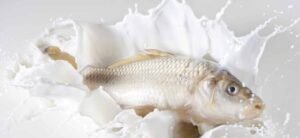Though the source of the myth remains unknown, for decades now, people all over the world have believed that consuming dairy products with seafood of any kind be it saltwater fish, freshwater fish, shellfish or crustaceans can lead to various skin-related conditions such as vitiligo. Because of the appearance of vitiligo as white patches on the skin, it has long been alleged that the condition is caused by the foods we eat, especially food that is white in colour.
Another theory suggests that as both are high protein foods, different types of enzymes are required to break them down. Our body requires a high amount of energy to digest the two foods when consumed together, which increases the workload on our digestive system. But while this can lead to gas pains, indigestion/upset stomach, bloating, heartburn or other issues of a digestive nature, allow us to dispel the myth right now –
THERE IS ABSOLUTELY NO CONNECTION BETWEEN SEAFOOD AND VITILIGO!
As documented by the UK’s National Health Service Vitiligo is an autoimmune disease where our body’s immune system kills the pigments in areas of our skin. The white patches on the skin are a result of a fungal infection or destruction of pigment-forming cells called melanocytes. As to why this happens exactly, we don’t know… But what we do know is that genetics plays a major role here.
Vitiligo is caused by the lack of a pigment called melanin in the skin. Melanin is produced by skin cells called melanocytes which give your skin its colour. In vitiligo, there are not enough working melanocytes to produce enough melanin in the skin.
But moving aside for a minute the fact that all medical research says the combination of seafood and dairy products is not harmful; there are many seafood dishes like Cod au Gratin, Baked Halibut Steaks or the timeless Tuna Melt in which dairy products like cheese feature prominently. The Italians have taken it one step further with the adoption of the classic tuna melt, and have since introduced the tonno quattro formaggi – a tuna melt made with four different types of cheese. Not to mention Mediterranean seafood specialties, which are a combination of fish with yogurt or milk.
If anything, the recipes of these dishes rebuke the theory of the two being even the slightest bit harmful when consumed together. The bottom line? While eating is a need, enjoying is an art. So mix and make merry, for all’s quiet on the seafood front!




